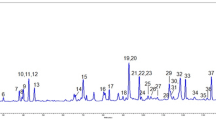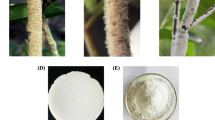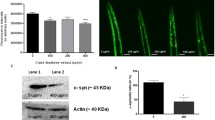Abstract
Betalain pigments are mainly produced by plants belonging to the order of Caryophyllales. Betalains exhibit strong antioxidant activity and responds to environmental stimuli and stress in plants. Recent reports of antioxidant, anti-inflammatory and anti-cancer properties of betalain pigments have piqued interest in understanding their biological functions. We investigated the effects of betalain pigments (betanin and isobetanin) derived from red-beet on amyloid-β (Aβ) aggregation, which causes Alzheimer’s disease. Non-specific inhibition of Aβ aggregation against Aβ40 and Aβ42 by red-beet betalain pigments, in vitro was demonstrated using the thioflavin t fluorescence assay, circular dichroism spectroscopy analysis, transmission electron microscopy and nuclear magnetic resonance (NMR) analysis. Furthermore, we examined the ability of red-beet betalain pigments to interfere with Aβ toxicity by using the transgenic Caenorhabditis elegans model, which expresses the human Aβ42 protein intracellularly within the body wall muscle. It responds to Aβ-toxicity with paralysis and treatment with 50 μM red-beet betalain pigments significantly delayed the paralysis of C. elegans. These results suggest that betalain pigments reduce Aβ-induced toxicity.



Similar content being viewed by others
Data Availability
Please contact Dr. Tomohiro Imamura and Dr. Masashi Mori.
References
Brockington SF, Walker RH, Glover BJ, Soltis PS, Soltis DE (2011) Complex pigment evolution in the Caryophyllales. New Phytol 190:854–864. https://doi.org/10.1111/j.1469-8137.2011.03687.x
Belhadj Slimen I, Najar T, Abderrabba M (2017) Chemical and antioxidant properties of betalains. J Agric Food Chem 65:675–689. https://doi.org/10.1021/acs.jafc.6b04208
Gómez-Maqueo A, Soccio M, Cano MP (2021) In vitro antioxidant capacity of Opuntia spp. fruits measured by the LOX-FL method and its high sensitivity towards betalains. Plant Foods Hum Nutr 76:354–362. https://doi.org/10.1007/s11130-021-00914-7
Lugo-Radillo A, Delgado-Enciso I, Peña-Beltrán E (2012) Betanidin significantly reduces blood glucose levels in BALB/c mice fed with an atherogenic diet. Nat Prod Bioprospect 2:154–155. https://doi.org/10.1007/s13659-012-0034-z
Martinez RM, Longhi-Balbinot DT, Zarpelon AC et al (2015) Anti-inflammatory activity of betalain-rich dye of Beta vulgaris: effect on edema, leukocyte recruitment, superoxide anion and cytokine production. Arch Pharm Res 38:494–504. https://doi.org/10.1007/s12272-014-0473-7
Nowacki L, Vigneron, P Rotellini L et al (2015) Betanin-enriched red beetroot (Beta vulgaris L.) extract induces apoptosis and autophagic cell death in MCF-7 cells. Phytother Res 29:1964–1973. https://doi.org/10.1002/ptr.5491
Imamura T, Isozumi N, Higashimura Yet al (2019) Isolation of amaranthin synthetase from Chenopodium quinoa and construction of an amaranthin production system using suspension-cultured tobacco BY-2 cells. Plant Biotechnol J 17: 969–981. https://doi.org/10.1111/pbi.13032
Shankar GM, Li S, Mehta TH, Garcia-Munoz Aet al (2008) Amyloid-beta protein dimers isolated directly from Alzheimer's brains impair synaptic plasticity and memory. Nature Med 14:837–842. https://doi.org/10.1038/nm1782
Cohen E, Bieschke J, Perciavalle RM, Kelly JW, Dillin A (2006) Opposing activities protect against age-onset proteotoxicity. Science 313:1604–1610. https://doi.org/10.1126/science.1124646
Ayaz M, Sadiq A, Junaid M et al (2019) Flavonoids as prospective neuroprotectants and their therapeutic propensity in aging associated neurological disorders. Front Aging Neurosci 11:155. https://doi.org/10.3389/fnagi.2019.00155
Williams RJ, Spencer JP (2012) Flavonoids, cognition, and dementia: actions, mechanisms, and potential therapeutic utility for Alzheimer disease. Free Radic Biol Med 52:35–45. https://doi.org/10.1016/j.freeradbiomed.2011.09.010
Alexander AG, Marfil V, Li C (2014) Use of Caenorhabditis elegans as a model to study Alzheimer's disease and other neurodegenerative diseases. Front Genet 5:279. https://doi.org/10.3389/fgene.2014.00279
Shaye DD, Greenwald I (2011) OrthoList: a compendium of C. elegans genes with human orthologs. PLoS One 6:e20085. https://doi.org/10.1371/journal.pone.0020085
Link CD (1995) Expression of human beta-amyloid peptide in transgenic Caenorhabditis elegans. Proc Natl Acad Sci USA 92:9368–9372. https://doi.org/10.1073/pnas.92.20.9368
Guo H, Cao M, Zou S, Ye B, Dong Y (2016) Cranberry extract standardized for proanthocyanidins alleviates β-amyloid peptide toxicity by improving proteostasis through HSF-1 in Caenorhabditis elegans model of Alzheimer's disease. J Gerontol A Biol Sci Med Sci 71:1564–1573. https://doi.org/10.1093/gerona/glv165
Jagota S, Rajadas J (2012) Effect of phenolic compounds against Aβ aggregation and Aβ-induced toxicity in transgenic C. elegans. Neurochem Res 37:40–48. https://doi.org/10.1007/s11064-011-0580-5
Henarejos-Escudero P, Guadarrama-Flores B, Guerrero-Rubio MA et al (2018) Development of betalain producing callus lines from colored quinoa varieties (Chenopodium quinoa Willd). J Agric Food Chem 66:467–474. https://doi.org/10.1021/acs.jafc.7b04642
Hao S, Li X, Han A et al (2020) Hydroxycinnamic acid from corncob and its structural analogues inhibit Aβ40 fibrillation and attenuate Aβ40-induced cytotoxicity. J Agric Food Chem 68:8788–8796. https://doi.org/10.1021/acs.jafc.0c01841
Hanaki M, Murakami K, Akagi K, Irie K (2016) Structural insights into mechanisms for inhibiting amyloid β42 aggregation by non-catechol-type flavonoids. Bioorg Med Chem 24:304–313. https://doi.org/10.1016/j.bmc.2015.12.021
Chen XQ, Mobley WC (2019) Alzheimer disease pathogenesis: insights from molecular and cellular biology studies of oligomeric Aβ and tau species. Front Neurosci 13:659. https://doi.org/10.3389/fnins.2019.00659
Herbach KM, Stintzing FC, Carle R (2006) Betalain stability and degradation — structural and chromatic aspects. J Food Sci 71:R41–R50. https://doi.org/10.1111/j.1750-3841.2006.00022.x
Pellarin R, Caflisch A (2006) Interpreting the aggregation kinetics of amyloid peptides. J Mol Biol 360:882–892. https://doi.org/10.1016/j.jmb.2006.05.033
Park SK, Tedesco PM, Johnson TE (2009) Oxidative stress and longevity in Caenorhabditis elegans as mediated by SKN-1. Aging Cell 8:258–269. https://doi.org/10.1111/j.1474-9726.2009.00473.x
Kim Y, Sun H (2007) Functional genomic approach to identify novel genes involved in the regulation of oxidative stress resistance and animal lifespan. Aging Cell 6:489–503. https://doi.org/10.1111/j.1474-9726.2007.00302.x
Leiser SF, Miller H, Rossner R et al (2015) Cell nonautonomous activation of flavin-containing monooxygenase promotes longevity and health span. Science 350:1375–1378. https://doi.org/10.1126/science.aac9257
Allegra M, Carletti F, Gambino G et al (2015) Indicaxanthin from Opuntia ficus-indica crosses the blood-brain barrier and modulates neuronal bioelectric activity in rat hippocampus at dietary-consistent amounts. J Agric Food Chem 63:7353–7360. https://doi.org/10.1021/acs.jafc.5b02612
Shunan D, Yu M, Guan H, Zhou Y (2021) Neuroprotective effect of betalain against AlCl3-induced Alzheimer’s disease in Sprague Dawley rats via putative modulation of oxidative stress and nuclear factor kappa B (NF-κB) signaling pathway. Biomed Pharmacother 137:111369. https://doi.org/10.1016/j.biopha.2021.111369
Acknowledgements
The authors thank Akiko Mizuno, Hiroko Hayashi, Mami Awatani, and Hitomi Nishikawa for their excellent technical assistance. The authors would like to thank Enago (www.enago.jp) for the English language review.
Funding
This work was partly supported by the Nanotechnology Platform of MEXT, Japan.
Author information
Authors and Affiliations
Contributions
MM conceived the study. TI and MM designed the experiments. TI purified red-beet betalain pigments. TI performed the ThT fluorescence assay. HK performed TEM observations. NI and SO performed CD spectroscopy analysis and NMR analysis. YH and ND conducted the nematode experiment. TS and HT performed RNA-seq analysis. KM and YH conducted the experiment using mice. TI, NI, YH, KM, and MM wrote the draft manuscript. All authors have read and approved the final manuscript.
Corresponding authors
Ethics declarations
Conflict of Interests
There is no conflict of interests to declare.
Additional information
Publisher’s Note
Springer Nature remains neutral with regard to jurisdictional claims in published maps and institutional affiliations.
Supplementary Information
ESM 1
(DOCX 493 kb)
Rights and permissions
About this article
Cite this article
Imamura, T., Isozumi, N., Higashimura, Y. et al. Red-Beet Betalain Pigments Inhibit Amyloid-β Aggregation and Toxicity in Amyloid-β Expressing Caenorhabditis elegans. Plant Foods Hum Nutr 77, 90–97 (2022). https://doi.org/10.1007/s11130-022-00951-w
Accepted:
Published:
Issue Date:
DOI: https://doi.org/10.1007/s11130-022-00951-w




